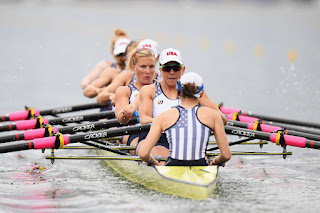
Rowing dates back to Egyptian times, but as a competitive sport, its origins date back to the early 18th century, when races were held on the River Thames in London, England. The rowing, or ‘crew’, as it is often known in the United States., is a sport in which a boat is propelled through the water through the use of oars. Today, rowing is for sporting or competitive purposes. There are two forms of rowing = sweep or rowing and rowing and rowing. The rower has a paddle, and this shape is usually done in pairs, fours, and eights. When paddling, each paddler has two paddles, and this shape is usually done in quads, doubles or singles.
The women’s eight victory in 2016 at the Olympics extended its world-title winning streak to 11 consecutive years.
In the modern Olympics, rowing was one of the original sports.
At the 2016 Rio Olympics, the U.S. women’s eight-won gold for the third consecutive Olympics, and the women’s single sculls won silver. At the Paralympics, the U.S. won silver in the legs, trunk and arms four.
The founder of the modern Olympics Baron Pierre de Coubertin was a rower.
At the 2012 London Olympic Games, the U.S. women’s eight-won gold for a second consecutive Olympics. At the Paralympics, the U.S. won bronze in the trunk and arms mixed double, a first in U.S. history.
The first intercollegiate sport in the United States was rowing and the first competitive race was held in 1852 between Yale and Harvard.
In 2008, the U.S. won gold in the women’s eight at the Olympic Games.
The first rowing club in the United States was founded in 1839. It was called the Detroit Boat Club.
Rowers are generally in superb physical condition.
In 2004, the U.S. men’s eight-won gold at the Olympic Games.
For 36 years, from 1920 until 1956, the United States won the gold medal in men’s rowing in the Olympics.
In 1999, the U.S. men’s eight won its third consecutive gold medal at the world championships, a first in U.S. history.
The famous baby doctor and author Dr. Benjamin Spock won a gold medal in 1924 in the men’s eight Olympics for rowing.
In 1997, Jamie Koven became the first American to win the men’s single sculls at the world championships since 1966.
The first national governing body for a sport in the United States was the National Association for Amateur Oarsmen, founded in 1872. In 1982 they changed their name to the United States Rowing Association.
Physiologists claim that rowing a 2,000-meter race – equivalent to 1.25 miles – is equal to playing back-to-back basketball games.
In rowing boats the long thin boats, they use are called shells.
Dr. Benjamin Spock, the famous baby doctor, was an Olympic rower in 1924 and won a gold medal in the eight. Gregory Peck rowed at the University of California in 1937.
The coxswain is the in-the-boat coach responsible for carrying out the training or race plan, and he or she is also responsible for motivating the rowers and calling out information. They are usually petite individuals, but if they are too petite, they must carry sandbags to bring them up to minimum weight.
FISA, the first international sports federation, was founded in 1892.
The rigger on the shell is the name of the apparatus sticking out at each seat that keeps the oar in place.
Yale College founded the first collegiate boat club in the U.S. in 1843.
The world’s largest annual regatta is Head of the Charles.
The first national governing body for a sport in the United States was for rowing. Founded as the National Association for Amateur Oarsmen in 1872, it was changed in 1982 to the United States Rowing Association.
The biggest spring season regatta is the Stotesbury Regatta in Philadelphia.
From 1920 until 1956, the USA won the gold medal in the men’s eight at every Olympic Games.
The biggest crew regatta in North America is the Royal Canadian Henley Regatta held each summer in St. Catharines, Ontario, Canada.
The first amateur sport organization was a rowing club – Philadelphia’s Schuylkill Navy, founded in 1858.
The most difficult and most important seat in the boat is the stroke, as the person sitting there is responsible for setting the tempo and determining the speed of strokes.
The first rowing club in the U.S. was the Detroit Boat Club, founded in 1839.
The middle seats are usually reserved for the strongest and largest rowers in the boat to improve the boat’s balance.
Singles may be as narrow as 10 inches across, weigh only 23 pounds, and stretch nearly 27-feet long.
The usual distance for a race is 2000 meters, although some high school sprints are only 1500 meters.
Rowing was the first intercollegiate sport contested in the United States. The first rowing race was between Harvard and Yale in 1852.
Shells with eight oars are usually 60 feet long.
Eight-oared shells are about 60-feet long – that’s 20 yards on a football field.
Single shells are usually 27 feet long and are often only 10 inches wide.
Rowers are the third largest U.S. delegation (48 athletes) to the Olympic Games.
In competitive rowing there are usually two weight classes, lightweight and heavyweight.
Physiologically, rowers are superb examples of physical conditioning. Cross-country skiers and long-distance speed skaters are comparable in terms of the physical demands the sport places on the athletes.
Rowing FAQs
Rowing is a fantastic full-body workout that can be enjoyed recreationally or competitively. Here are some commonly asked questions to get you started:
1. What is rowing?
Rowing is a sport or exercise that involves propelling a boat on water using oars. It utilizes a sliding seat mechanism, allowing for powerful strokes generated by the legs, core, and back. Rowing can be done individually (single sculling) or in teams (double sculling, quad sculling, eight-oared crew).
2. What are the benefits of rowing?
Rowing offers a multitude of benefits:
- Full-body workout: It engages almost all major muscle groups, improving strength, endurance, and cardiovascular health.
- Low impact: Unlike some high-impact exercises, rowing is gentle on your joints, making it suitable for people of all ages and fitness levels.
- Mental benefits: The rhythmic nature of rowing can be meditative and promote stress reduction.
- Teamwork: Rowing in a crew fosters teamwork, coordination, and communication skills.
3. What equipment do I need to start rowing?
For beginners, trying rowing at a boathouse or club is the best option. They will provide all the necessary equipment:
- Boat: Depending on the chosen format (single, double, etc.), a rowing shell will be available.
- Oars: These come in different lengths and weights depending on the boat and rower.
- Seat and slides: The sliding seat allows for efficient stroke mechanics.
- Lockers: Facilities usually offer lockers to store belongings.
4. What should I wear for rowing?
Comfortable, close-fitting clothing is key. Opt for:
- Shorts or spandex: Baggy clothes can get caught in the seat tracks.
- T-shirt or athletic top: Avoid loose clothing or dangling accessories.
- Hat (optional): For sun protection on sunny days.
- Lightweight socks: Shoes are not needed in the boat itself.
- Sunscreen and sunglasses (optional): For sun protection on sunny days.
5. What are the basic mechanics of rowing?
The rowing stroke involves a sequence of movements:
- Catch: The rower dips the oar blade into the water with straight arms and a strong core.
- Drive: Legs push back, sliding the seat forward while pulling the oar towards the body.
- Finish: Oar blade is lifted out of the water at the end of the stroke with the torso slightly leaning back.
- Recovery: Legs relax, sliding the seat forward while arms extend, preparing for the next catch.
6. How do I learn to row?
Most rowing clubs or boathouses offer beginner programs with qualified instructors. They will guide you through proper technique, safety procedures, and on-water practice.
7. Is rowing competitive?
Yes, rowing has a strong competitive scene with races held at various levels, from local regattas to international championships like the Olympics. However, many people also enjoy rowing recreationally for exercise and enjoyment.
8. Where can I find a rowing club or boathouse?
Many communities have rowing clubs or boathouses. You can search online or contact your local parks and recreation department for information. National rowing organizations like USRowing (USA) or British Rowing (UK) can also provide resources to find rowing opportunities.
9. What are some safety considerations for rowing?
Safety is paramount in rowing. Here are some things to keep in mind:
- Always follow instructions from qualified coaches or instructors.
- Be aware of weather conditions and never row alone in bad weather.
- Wear a life jacket if required or recommended.
- Be mindful of other boats and watercraft while sharing the waterway.
10. Is rowing expensive?
Costs can vary depending on the location and program type. Many clubs offer introductory memberships or classes at a reasonable cost. Once you’re hooked, you may need to invest in some personal rowing gear like gloves or specialized clothing.
I hope this comprehensive FAQ piques your interest in rowing! It’s a rewarding activity that offers a great workout and a chance to connect with nature and potentially a supportive rowing community.









